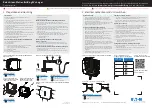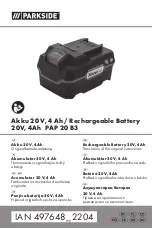
14
INSTRUCTIONS FOR USE
EN
BATTERY CHARGING
C
K
arging batteries connected to t
K
e ve
K
icle
1. Before starting to charge the battery, make sure the power supply lead is not plugged into the mains supply.
2. Locate the vehicle’s earthing point, which is normally connected to the negative battery terminal.
3. Charging a battery with negative earth, grounded to the vehicle’s chassis.
• Connect the output lead with the red clamp to the positive terminal (+) of the battery.
• Connect the output lead with the black clamp to the vehicle’s earthing point, keeping it away from the battery and
from the fuel pipe.
4. Charging a battery with positive earth, grounded to the vehicle’s chassis.
• Connect the output lead with the black clamp to the negative terminal (-) of the battery.
• Connect the output lead with the red clamp to the vehicle’s earthing point, keeping it away from the battery and from
the fuel pipe.
Connecting batteries t
K
at are not connected to a ve
K
icle
1. Before starting to charge the battery, make sure the power supply lead is not plugged into the mains supply.
2. Connect the output lead with the red clamp to the positive terminal (+) of the battery.
3. Connect the output lead with the black clamp to the negative terminal (-) of the battery.
ATTENTION
Ma
N
e s
X
re bot
K
clamps o
I
t
K
e o
X
tp
X
t leads generate a s
X
itable contact wit
K
t
K
eir corresponding terminals.
OPERATING THE CHARGER
1. Once the output leads have been connected to the battery, plug the power supply lead of the battery charger into the mains,
making sure the voltage matches the nominal voltage of the battery charger (230V-50Hz); having done this, the charger will emit
an acoustic signal for 0.5 seconds, and all the LED indicators on the control panel will switch on for 2 seconds; at this stage, the
display shows “- - - -”.
2. The battery charger is con
¿
gured in “stand-by” mode; for example: ON LED lit,
:
ET LED lit, CHARGE LED 5-50Ah lit. The
LEDs light up differently based on the last programme saved (see section “Saving Charging Cycles”).
3. At this stage, with the battery charger in “stand-by” mode, set the charging parameters suitable for the type of battery to be
charged, using the buttons on the control panel. The charging parameters selected are displayed by the corresponding LED,
which switches on.
Settable c
K
arging parameters
• Function key: (see section A – Operating Modes: “Function”) depending on the work cycle, select:
- Flash, Charge or Recovery.
• Amperage key: (see section B – Supply and charging mode: “Amperage”)
Based on the supply current required to support the battery voltage during reprogramming operations, you can select four
different supply currents:
If you select the FLASH function, you can choose among the following options:
- Flash 5A: the battery charger delivers a constant current of 5A
- Flash 15A: the battery charger delivers a constant current of 15A
- Flash 30A: the battery charger delivers a constant current of 30A
- Flash 50A: the battery charger delivers a constant current of 50A
If you select the CHARGE function: Based on the capacity of the battery, select:
- Charge 5Ah/50Ah: charge for batteries with capacity from 5Ah to 50Ah
- Charge 50Ah/150Ah: charge for batteries with capacity from 50Ah to 150Ah
- Charge 150Ah/300Ah: charge for batteries with capacity from 150Ah to 300Ah
- Charge 300Ah/500Ah: charge for batteries with capacity from 300Ah to 500Ah















































